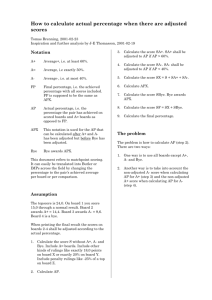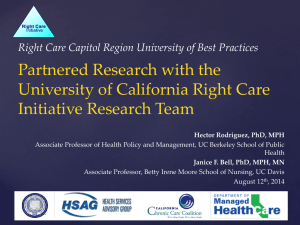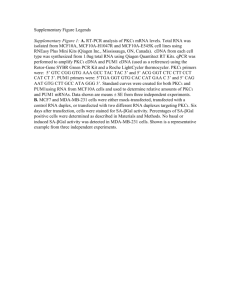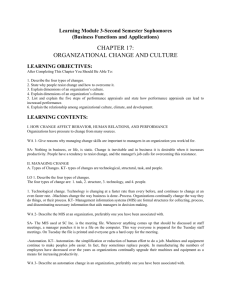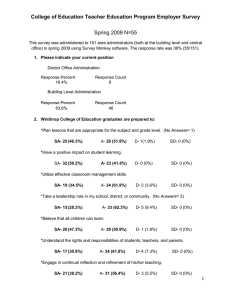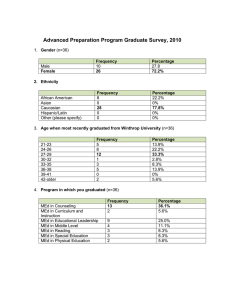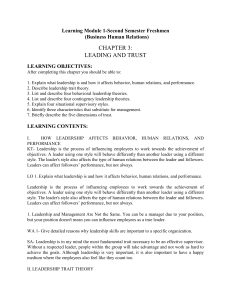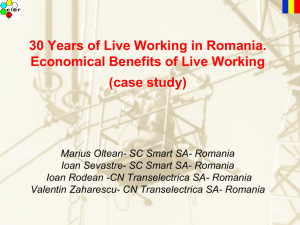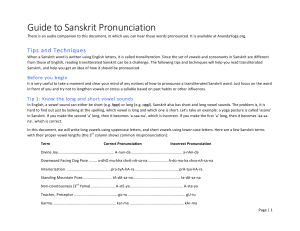Multisector Programs: Extent of Integration in FAFSA
advertisement
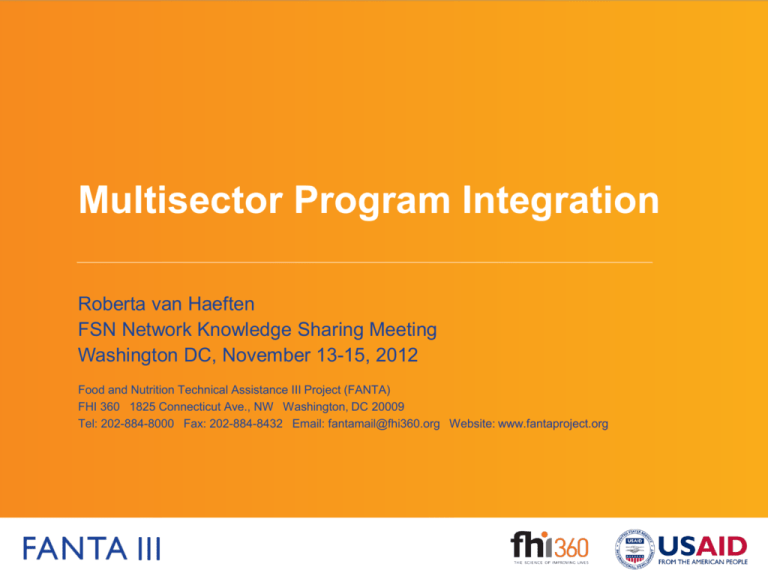
Multisector Program Integration Roberta van Haeften FSN Network Knowledge Sharing Meeting Washington DC, November 13-15, 2012 Food and Nutrition Technical Assistance III Project (FANTA) FHI 360 1825 Connecticut Ave., NW Washington, DC 20009 Tel: 202-884-8000 Fax: 202-884-8432 Email: fantamail@fhi360.org Website: www.fantaproject.org III FA F SA- 2 Multisector Programs: Their Rationale Strong links between poverty (lack of income), lack of access to food, and undernutrition • Illustrated in the Food Security Conceptual Framework Logic Evidence III • Economic growth helps increase food demand and improve nutritional outcomes (World Bank) • “Economic growth is good but not sufficient to improve child nutrition” (IFPRI) FA F SA- 2 Food Security Conceptual Framework Developed for Use in the FAFSA-2 Adapted by Roberta van Haeften and Mary Ann Anderson from Riely et al., 1999 and UNICEF, 1990. III FA F SA- 2 Multisector Programs in Title II USAID/FFP Guidance • No preference expressed for multisector programs • Only guidance on how to handle if this option selected • Several recommended multisector programs and improvements in program integration Food Security Programming • Bangladesh, Burkina Faso, Malawi Frameworks III FA F SA- 2 Multisector Programs During The FAFSA-2 Time Period Popular Not Well Documented III • Most programs included at least two technical sectors – AG/NRM/LH and MCHN • The degree of integration • The impact of integration FA F SA- 2 Multisector Programs in FAFSA-2 Goal: Improve Food Security/ Reduce Food Insecurity Strategic Objective: MCHN (82 Programs) 72 Programs with Both Objectives Strategic Objective: AG/LH (79 Programs) FAFSA-2 Universe – 101 Programs in 28 Countries III FA F SA- 2 Integration of Multisector Programs • Definition – programs that have activities in two or more technical sectors operating in the same geographic area and/or serving the same target population III • Geographic co-location, i.e., delivering services in the same: – Country? – Major region? – Sub-unit (administrative sub-division, agro ecological)? – Community? – Household???? FA F SA- 2 Integration of Multisector Programs Delivering program services to the same target groups? Food Insecure Communities – Increasing Community Capacity and Reducing Vulnerability Farm Households (Including the Food Insecure) – Improving Livelihoods and Incomes Households with Children under Two and Pregnant and Lactating Women – Reducing Chronic Child Undernutrition III FA F SA- 2 Multisector Programs: Extent of Integration in FAFSA-2 Few programs reported on the extent of program integration At the Community Level: • CRS/Ethiopia • CRS/Madagascar • SC/Uganda III At the Household Level: • The four Guatemala programs – CARE, CRS, SC, SHARE • The four Haiti programs – CARE, CRS, SC, WV FA F SA- 2 Multisector Programs: Few Programs Reported on Results of Integration Bangladesh SC (FY 2005–2010) found that its program almost achieved its nutritional goals in the unions where it did both food access (LH) and food utilization (HN) interventions while nutritional improvement was minimal in unions where it only did HN. CARE (FY 2005–2010) documented a positive correlation between the Household Dietary Diversity Score and number of project components in which households participated. Bolivia The joint final evaluation of the four programs concluded that the impressive reductions in stunting and underweight were due to doubling or quadrupling incomes plus effective CBGP, SBCC, and health services in the same communities. III FA F SA- 2 Multisector Programs: Constraints to Increased Integration Serious trade-offs may be required due to differences in: – Resource requirements by sector – Program dynamics and time requirements – Coverage and capacities of government service providers – Sustainability strategies III FA F SA- 2 This presentation is made possible by the generous support of the American people through the support of the Office of Food for Peace, Bureau for Democracy, Conflict and Humanitarian Assistance, and the Office of Health, Infectious Diseases and Nutrition, Bureau for Global Health, U.S. Agency for International Development (USAID), under terms of Cooperative Agreement No. AID-OAA-A-12-00005, through FANTA, managed by FHI 360. The contents are the responsibility of FHI 360 and do not necessarily reflect the views of USAID or the United States Government. III FA F SA- 2
